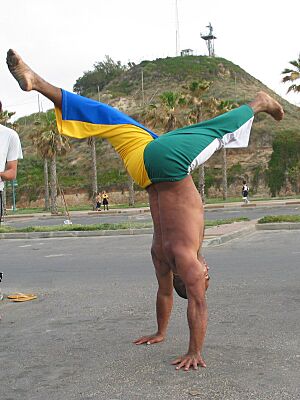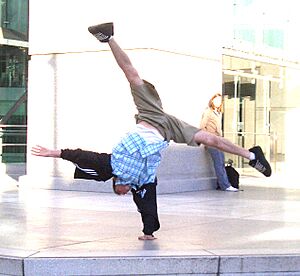Handstand facts for kids
A handstand is when you hold your body upside down, balancing only on your hands! Imagine standing on your hands instead of your feet. Your body should be straight, with your arms and legs stretched out. Your hands are usually placed about as wide as your shoulders. To do a handstand well, you need good balance and strong upper body strength.
Handstands are used in many cool activities. You'll see them in acro dance, acrobatics, and gymnastics. Gymnasts often use some type of handstand on all their equipment. Many tumbling moves even pass through a handstand position. Breakdancers use handstands in their amazing freezes and kicks. Sometimes, a handstand is even a starting position for diving into water! Swimmers might also do underwater handstands in pools, with their legs sticking out of the water.
Handstands have different names around the world. In yoga, it's called Adho Mukha Vrksasana, which means "Downward-facing Tree Pose." In capoeira, a Brazilian martial art, it's known as bananeira.
Handstand Styles
In modern gymnastics, there are two main ways to do a handstand: the curved-back style and the straight-back style. The straight-back style is used when gymnasts want a perfectly straight body line. But often, the curved-back style is better because it gives you more control over your balance. You keep your balance by gently shifting your weight towards your fingers or the heel of your hand.
All basic handstands share these important features:
- Straight arms with your hands on the ground, about shoulder-width apart.
- Straight legs, held tightly together.
- Pointed toes to make your legs look long and straight.
Straight-back handstands have these special features:
- Tucked head (your face points forward) as if you were standing upright.
- Straight spine, with your hips pushed slightly forward. If you were lying flat, this would make your lower back touch the ground.
Cool Handstand Tricks
There are many fun and challenging ways to do a handstand:
- Split Legs: You can hold your legs in a side or front split while upside down.
- Stag Split: This is a front split, but with your knees bent.
- Arched Back: You can arch your back a lot, bending your knees so your toes touch the back of your head.
- Hollowback: Your back bends so much that your legs go even further forward than your head.
- One-Handed: This is super tricky! You balance on just one hand.
- Handstand Push-ups: While in a handstand, you lower and raise your body using only your arm strength.

Related Topics
Images for kids
See also
 In Spanish: Equilibrio invertido de brazos para niños
In Spanish: Equilibrio invertido de brazos para niños




